Nursing Assignment: Case Study of Mrs. Valerie Jackson's Arrhythmia
VerifiedAdded on 2020/03/07
|11
|3151
|271
Report
AI Summary
This nursing assignment focuses on the case of Mrs. Valerie Jackson, a 65-year-old patient diagnosed with cardiac arrhythmia following a large bowel resection. The report begins with an introduction to evidence-based practice in nursing, emphasizing patient assessment, interpretation, and decision-making. It then delves into the pathophysiology of cardiac arrhythmia, explaining abnormal heart rhythms through discussions of enhanced/suppressed automaticity and triggered activity. The assignment analyzes Mrs. Jackson's vital signs, including sinus tachycardia, and pathology results, interpreting electrolyte imbalances like hypernatremia, hypomagnesemia, and hypochloremia, and their impact on cardiac function. Based on these findings, the report identifies key assessment needs and proposes three crucial nursing interventions: preoperative care for bowel resection, maintaining fluid and electrolyte balance through intravenous fluids and monitoring, and managing cardiac arrhythmia through regular pulse monitoring, ECG tracing, and physician consultation. The assignment highlights the importance of addressing both the immediate cardiac issues and the underlying electrolyte imbalances to improve patient outcomes and prevent complications.

Running head: NURSING ASSIGNMENT
Nursing assignment
Name of the student:
Name of the University:
Author’s note
Nursing assignment
Name of the student:
Name of the University:
Author’s note
Paraphrase This Document
Need a fresh take? Get an instant paraphrase of this document with our AI Paraphraser
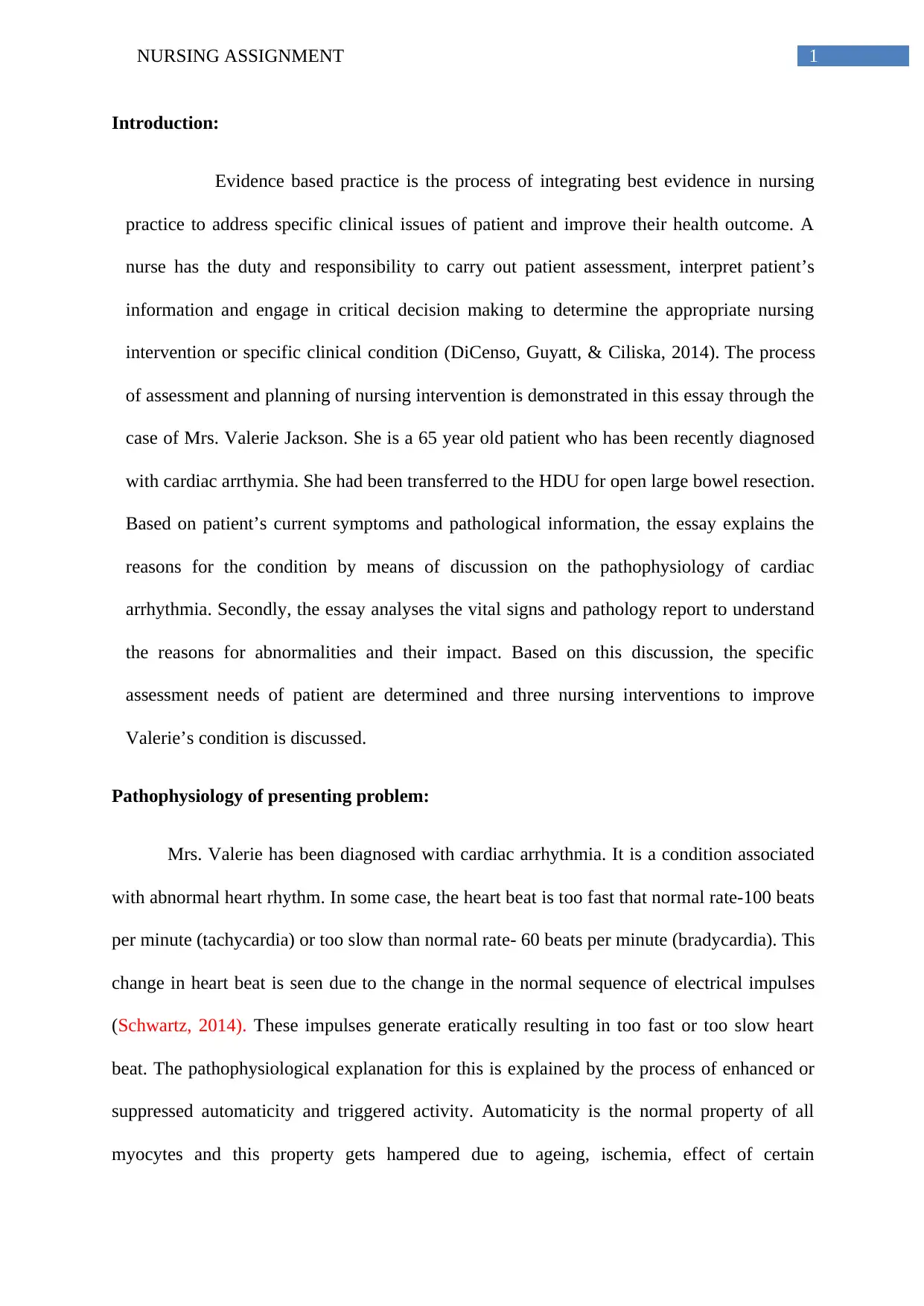
1NURSING ASSIGNMENT
Introduction:
Evidence based practice is the process of integrating best evidence in nursing
practice to address specific clinical issues of patient and improve their health outcome. A
nurse has the duty and responsibility to carry out patient assessment, interpret patient’s
information and engage in critical decision making to determine the appropriate nursing
intervention or specific clinical condition (DiCenso, Guyatt, & Ciliska, 2014). The process
of assessment and planning of nursing intervention is demonstrated in this essay through the
case of Mrs. Valerie Jackson. She is a 65 year old patient who has been recently diagnosed
with cardiac arrthymia. She had been transferred to the HDU for open large bowel resection.
Based on patient’s current symptoms and pathological information, the essay explains the
reasons for the condition by means of discussion on the pathophysiology of cardiac
arrhythmia. Secondly, the essay analyses the vital signs and pathology report to understand
the reasons for abnormalities and their impact. Based on this discussion, the specific
assessment needs of patient are determined and three nursing interventions to improve
Valerie’s condition is discussed.
Pathophysiology of presenting problem:
Mrs. Valerie has been diagnosed with cardiac arrhythmia. It is a condition associated
with abnormal heart rhythm. In some case, the heart beat is too fast that normal rate-100 beats
per minute (tachycardia) or too slow than normal rate- 60 beats per minute (bradycardia). This
change in heart beat is seen due to the change in the normal sequence of electrical impulses
(Schwartz, 2014). These impulses generate eratically resulting in too fast or too slow heart
beat. The pathophysiological explanation for this is explained by the process of enhanced or
suppressed automaticity and triggered activity. Automaticity is the normal property of all
myocytes and this property gets hampered due to ageing, ischemia, effect of certain
Introduction:
Evidence based practice is the process of integrating best evidence in nursing
practice to address specific clinical issues of patient and improve their health outcome. A
nurse has the duty and responsibility to carry out patient assessment, interpret patient’s
information and engage in critical decision making to determine the appropriate nursing
intervention or specific clinical condition (DiCenso, Guyatt, & Ciliska, 2014). The process
of assessment and planning of nursing intervention is demonstrated in this essay through the
case of Mrs. Valerie Jackson. She is a 65 year old patient who has been recently diagnosed
with cardiac arrthymia. She had been transferred to the HDU for open large bowel resection.
Based on patient’s current symptoms and pathological information, the essay explains the
reasons for the condition by means of discussion on the pathophysiology of cardiac
arrhythmia. Secondly, the essay analyses the vital signs and pathology report to understand
the reasons for abnormalities and their impact. Based on this discussion, the specific
assessment needs of patient are determined and three nursing interventions to improve
Valerie’s condition is discussed.
Pathophysiology of presenting problem:
Mrs. Valerie has been diagnosed with cardiac arrhythmia. It is a condition associated
with abnormal heart rhythm. In some case, the heart beat is too fast that normal rate-100 beats
per minute (tachycardia) or too slow than normal rate- 60 beats per minute (bradycardia). This
change in heart beat is seen due to the change in the normal sequence of electrical impulses
(Schwartz, 2014). These impulses generate eratically resulting in too fast or too slow heart
beat. The pathophysiological explanation for this is explained by the process of enhanced or
suppressed automaticity and triggered activity. Automaticity is the normal property of all
myocytes and this property gets hampered due to ageing, ischemia, effect of certain

2NURSING ASSIGNMENT
medications and other factors (Tse, 2016). The advancing age of Valerie might be a reason for
change in property of automaticity. The condition of suppressed automaticity leads to
dysfunction of sinus node and the enhanced automaticity leads to multiple arrhythmia
(Yabluchansky et al., 2016). This condition can be identified in patient by the symptoms of
dizziness, loss of consciousness, shortness of breath and chest discomfort.
Triggered activity is another condition or mechanism behind cardiac arrhythmia. It is
the initiation of impulse on the basis of afterdepolarization. However, triggered activity
occurs when both early depolarization and after depolarization initiates at the same time. This
form of abnormal impulse excitation results in reentrant excitation (Antzelevitch et al., 2014).
In contrast with the condition of cardiac arrhythmia, normal cardiac rhythm is seen when
spontaneous impulse is generated from the sinoatrial node and transmitted to the myocardium
(Ruthruff & Lien, 2016). Hence, in normal condition, impulse formation and transmission to
the atrial and ventricular mycocardium occurs in a synchronous pattern. However, myocardial
disease and certain cardioactive drugs disrupts the normal cardiac rhythm and changes the
activity of the sinus node. Major changes is observed in automaticity of the myocardium that
results in compromised cardiac function and adverse symptoms in patients like Valeria (van
der Lende et al., 2015).
Interpretation of rhytm:
The examination of the rhythm strips of Mrs. Valerie indicates the condition of sinus
tachycardia or abrupt increase of heart rhythm. This is defined by a value greater than 100
beats/minute. The event is traced by the PQRST wave on the rhythm strip. P wave
represents the discharge of the SA node and depolarization of the atria. The pattern of the
wave indicates condition of tachycardia in Mrs. Valerie and this might have occurred
because of increase in demand of oxygen due to stress, infection or blood loss. Mrs. Valerie
medications and other factors (Tse, 2016). The advancing age of Valerie might be a reason for
change in property of automaticity. The condition of suppressed automaticity leads to
dysfunction of sinus node and the enhanced automaticity leads to multiple arrhythmia
(Yabluchansky et al., 2016). This condition can be identified in patient by the symptoms of
dizziness, loss of consciousness, shortness of breath and chest discomfort.
Triggered activity is another condition or mechanism behind cardiac arrhythmia. It is
the initiation of impulse on the basis of afterdepolarization. However, triggered activity
occurs when both early depolarization and after depolarization initiates at the same time. This
form of abnormal impulse excitation results in reentrant excitation (Antzelevitch et al., 2014).
In contrast with the condition of cardiac arrhythmia, normal cardiac rhythm is seen when
spontaneous impulse is generated from the sinoatrial node and transmitted to the myocardium
(Ruthruff & Lien, 2016). Hence, in normal condition, impulse formation and transmission to
the atrial and ventricular mycocardium occurs in a synchronous pattern. However, myocardial
disease and certain cardioactive drugs disrupts the normal cardiac rhythm and changes the
activity of the sinus node. Major changes is observed in automaticity of the myocardium that
results in compromised cardiac function and adverse symptoms in patients like Valeria (van
der Lende et al., 2015).
Interpretation of rhytm:
The examination of the rhythm strips of Mrs. Valerie indicates the condition of sinus
tachycardia or abrupt increase of heart rhythm. This is defined by a value greater than 100
beats/minute. The event is traced by the PQRST wave on the rhythm strip. P wave
represents the discharge of the SA node and depolarization of the atria. The pattern of the
wave indicates condition of tachycardia in Mrs. Valerie and this might have occurred
because of increase in demand of oxygen due to stress, infection or blood loss. Mrs. Valerie
⊘ This is a preview!⊘
Do you want full access?
Subscribe today to unlock all pages.

Trusted by 1+ million students worldwide
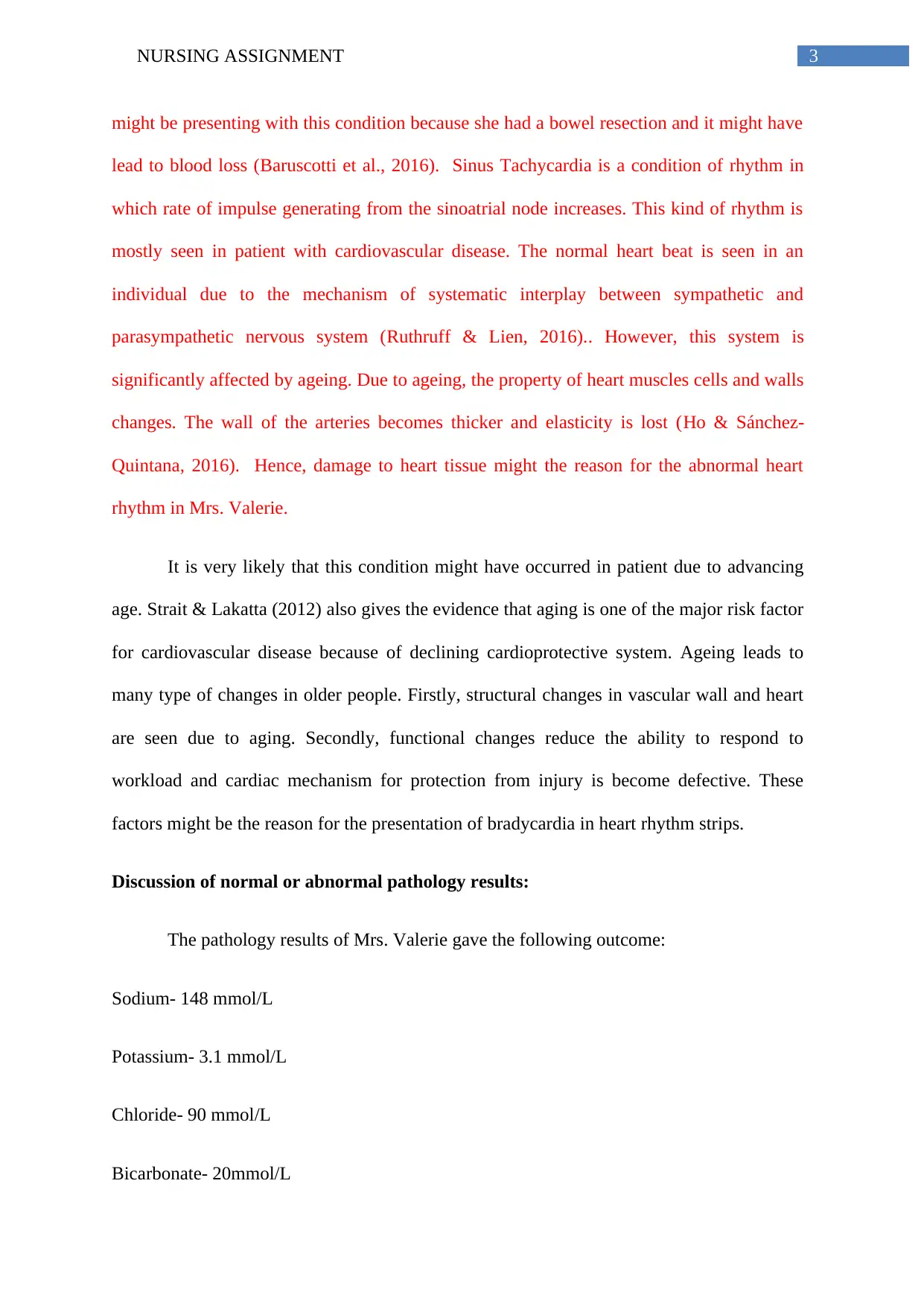
3NURSING ASSIGNMENT
might be presenting with this condition because she had a bowel resection and it might have
lead to blood loss (Baruscotti et al., 2016). Sinus Tachycardia is a condition of rhythm in
which rate of impulse generating from the sinoatrial node increases. This kind of rhythm is
mostly seen in patient with cardiovascular disease. The normal heart beat is seen in an
individual due to the mechanism of systematic interplay between sympathetic and
parasympathetic nervous system (Ruthruff & Lien, 2016).. However, this system is
significantly affected by ageing. Due to ageing, the property of heart muscles cells and walls
changes. The wall of the arteries becomes thicker and elasticity is lost (Ho & Sánchez-
Quintana, 2016). Hence, damage to heart tissue might the reason for the abnormal heart
rhythm in Mrs. Valerie.
It is very likely that this condition might have occurred in patient due to advancing
age. Strait & Lakatta (2012) also gives the evidence that aging is one of the major risk factor
for cardiovascular disease because of declining cardioprotective system. Ageing leads to
many type of changes in older people. Firstly, structural changes in vascular wall and heart
are seen due to aging. Secondly, functional changes reduce the ability to respond to
workload and cardiac mechanism for protection from injury is become defective. These
factors might be the reason for the presentation of bradycardia in heart rhythm strips.
Discussion of normal or abnormal pathology results:
The pathology results of Mrs. Valerie gave the following outcome:
Sodium- 148 mmol/L
Potassium- 3.1 mmol/L
Chloride- 90 mmol/L
Bicarbonate- 20mmol/L
might be presenting with this condition because she had a bowel resection and it might have
lead to blood loss (Baruscotti et al., 2016). Sinus Tachycardia is a condition of rhythm in
which rate of impulse generating from the sinoatrial node increases. This kind of rhythm is
mostly seen in patient with cardiovascular disease. The normal heart beat is seen in an
individual due to the mechanism of systematic interplay between sympathetic and
parasympathetic nervous system (Ruthruff & Lien, 2016).. However, this system is
significantly affected by ageing. Due to ageing, the property of heart muscles cells and walls
changes. The wall of the arteries becomes thicker and elasticity is lost (Ho & Sánchez-
Quintana, 2016). Hence, damage to heart tissue might the reason for the abnormal heart
rhythm in Mrs. Valerie.
It is very likely that this condition might have occurred in patient due to advancing
age. Strait & Lakatta (2012) also gives the evidence that aging is one of the major risk factor
for cardiovascular disease because of declining cardioprotective system. Ageing leads to
many type of changes in older people. Firstly, structural changes in vascular wall and heart
are seen due to aging. Secondly, functional changes reduce the ability to respond to
workload and cardiac mechanism for protection from injury is become defective. These
factors might be the reason for the presentation of bradycardia in heart rhythm strips.
Discussion of normal or abnormal pathology results:
The pathology results of Mrs. Valerie gave the following outcome:
Sodium- 148 mmol/L
Potassium- 3.1 mmol/L
Chloride- 90 mmol/L
Bicarbonate- 20mmol/L
Paraphrase This Document
Need a fresh take? Get an instant paraphrase of this document with our AI Paraphraser

4NURSING ASSIGNMENT
Magnesium- 0.50 mmol/L
Phosphate- 0.60 mmol/L
The normal level of sodium in blood is between 135mmol/L to 145mmmol/L,
however Mrs. Valerie’s sodium level was 148 mmmol/L which is slight high. A high sodium
level may lead to the condition of hypernatremia. This kind of electrolyte imbalance may be
caused by dehydration, endocrine disease, hyperventilation and use of drugs like steroids and
blood pressure lowering medication (Hauptman et al., 2013). Due to this condition, Mrs.
Valerie may have symptoms of sweating, fever, dizziness and diarrhea. She might exhibit this
condition due to decrease in water excretion. This might lead to hazardous complication in
patient and heart rate variability. High salt is likely to increase blood pressure, decrease heart
rate and increase the frequency of changes in heart rate (McNeely, Windham, & Anderson,
2008). Hence, hypernatremia is a major clinical presentation for patients with high blood
sodium levels. Symptoms may range from mild signs like nausea and vomiting to severe
signs like seizures and coma.
Magnesium and potassium plays an important role in the development of cardiac
arrthythmia in patient. The magnesium and potassium level in blood of Mrs. Valerie was 3.3
mmol/L and 0.50 mmol/L respectively. Both values are below the normal threshold value as
normal volume of magnesium and potassium in blood are 3.5 to 5.0 mmol/L and 0.7 to 1.10
mmol/L. Low magnesium level may lead to the clinical presentation of hypomagnesium in
patient. Normal magnesium level is important for maintenance of heart and nervous system
function. The condition may be caused by low magnesium in diet, renal damage, endocrine
disorder and high excretion of magnesium from the body. Magnesium depletion is the major
cause of diagnosis of arrhythmias in patient (Efstratiadis, Sarigianni, & Gougourelas, 2006).
Magnesium maintains intracellular concentration and the depletion of the same leads to
Magnesium- 0.50 mmol/L
Phosphate- 0.60 mmol/L
The normal level of sodium in blood is between 135mmol/L to 145mmmol/L,
however Mrs. Valerie’s sodium level was 148 mmmol/L which is slight high. A high sodium
level may lead to the condition of hypernatremia. This kind of electrolyte imbalance may be
caused by dehydration, endocrine disease, hyperventilation and use of drugs like steroids and
blood pressure lowering medication (Hauptman et al., 2013). Due to this condition, Mrs.
Valerie may have symptoms of sweating, fever, dizziness and diarrhea. She might exhibit this
condition due to decrease in water excretion. This might lead to hazardous complication in
patient and heart rate variability. High salt is likely to increase blood pressure, decrease heart
rate and increase the frequency of changes in heart rate (McNeely, Windham, & Anderson,
2008). Hence, hypernatremia is a major clinical presentation for patients with high blood
sodium levels. Symptoms may range from mild signs like nausea and vomiting to severe
signs like seizures and coma.
Magnesium and potassium plays an important role in the development of cardiac
arrthythmia in patient. The magnesium and potassium level in blood of Mrs. Valerie was 3.3
mmol/L and 0.50 mmol/L respectively. Both values are below the normal threshold value as
normal volume of magnesium and potassium in blood are 3.5 to 5.0 mmol/L and 0.7 to 1.10
mmol/L. Low magnesium level may lead to the clinical presentation of hypomagnesium in
patient. Normal magnesium level is important for maintenance of heart and nervous system
function. The condition may be caused by low magnesium in diet, renal damage, endocrine
disorder and high excretion of magnesium from the body. Magnesium depletion is the major
cause of diagnosis of arrhythmias in patient (Efstratiadis, Sarigianni, & Gougourelas, 2006).
Magnesium maintains intracellular concentration and the depletion of the same leads to
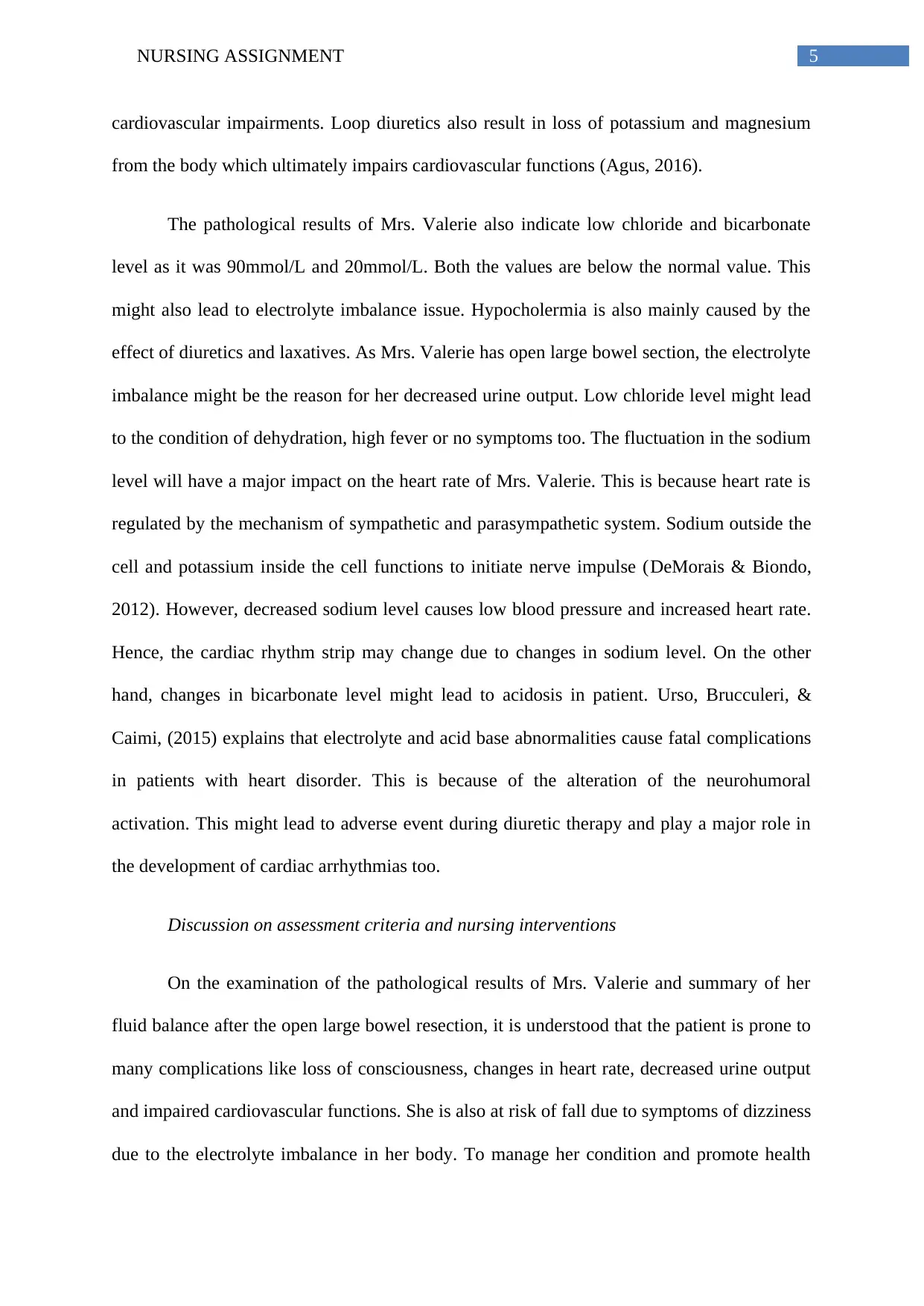
5NURSING ASSIGNMENT
cardiovascular impairments. Loop diuretics also result in loss of potassium and magnesium
from the body which ultimately impairs cardiovascular functions (Agus, 2016).
The pathological results of Mrs. Valerie also indicate low chloride and bicarbonate
level as it was 90mmol/L and 20mmol/L. Both the values are below the normal value. This
might also lead to electrolyte imbalance issue. Hypocholermia is also mainly caused by the
effect of diuretics and laxatives. As Mrs. Valerie has open large bowel section, the electrolyte
imbalance might be the reason for her decreased urine output. Low chloride level might lead
to the condition of dehydration, high fever or no symptoms too. The fluctuation in the sodium
level will have a major impact on the heart rate of Mrs. Valerie. This is because heart rate is
regulated by the mechanism of sympathetic and parasympathetic system. Sodium outside the
cell and potassium inside the cell functions to initiate nerve impulse (DeMorais & Biondo,
2012). However, decreased sodium level causes low blood pressure and increased heart rate.
Hence, the cardiac rhythm strip may change due to changes in sodium level. On the other
hand, changes in bicarbonate level might lead to acidosis in patient. Urso, Brucculeri, &
Caimi, (2015) explains that electrolyte and acid base abnormalities cause fatal complications
in patients with heart disorder. This is because of the alteration of the neurohumoral
activation. This might lead to adverse event during diuretic therapy and play a major role in
the development of cardiac arrhythmias too.
Discussion on assessment criteria and nursing interventions
On the examination of the pathological results of Mrs. Valerie and summary of her
fluid balance after the open large bowel resection, it is understood that the patient is prone to
many complications like loss of consciousness, changes in heart rate, decreased urine output
and impaired cardiovascular functions. She is also at risk of fall due to symptoms of dizziness
due to the electrolyte imbalance in her body. To manage her condition and promote health
cardiovascular impairments. Loop diuretics also result in loss of potassium and magnesium
from the body which ultimately impairs cardiovascular functions (Agus, 2016).
The pathological results of Mrs. Valerie also indicate low chloride and bicarbonate
level as it was 90mmol/L and 20mmol/L. Both the values are below the normal value. This
might also lead to electrolyte imbalance issue. Hypocholermia is also mainly caused by the
effect of diuretics and laxatives. As Mrs. Valerie has open large bowel section, the electrolyte
imbalance might be the reason for her decreased urine output. Low chloride level might lead
to the condition of dehydration, high fever or no symptoms too. The fluctuation in the sodium
level will have a major impact on the heart rate of Mrs. Valerie. This is because heart rate is
regulated by the mechanism of sympathetic and parasympathetic system. Sodium outside the
cell and potassium inside the cell functions to initiate nerve impulse (DeMorais & Biondo,
2012). However, decreased sodium level causes low blood pressure and increased heart rate.
Hence, the cardiac rhythm strip may change due to changes in sodium level. On the other
hand, changes in bicarbonate level might lead to acidosis in patient. Urso, Brucculeri, &
Caimi, (2015) explains that electrolyte and acid base abnormalities cause fatal complications
in patients with heart disorder. This is because of the alteration of the neurohumoral
activation. This might lead to adverse event during diuretic therapy and play a major role in
the development of cardiac arrhythmias too.
Discussion on assessment criteria and nursing interventions
On the examination of the pathological results of Mrs. Valerie and summary of her
fluid balance after the open large bowel resection, it is understood that the patient is prone to
many complications like loss of consciousness, changes in heart rate, decreased urine output
and impaired cardiovascular functions. She is also at risk of fall due to symptoms of dizziness
due to the electrolyte imbalance in her body. To manage her condition and promote health
⊘ This is a preview!⊘
Do you want full access?
Subscribe today to unlock all pages.

Trusted by 1+ million students worldwide
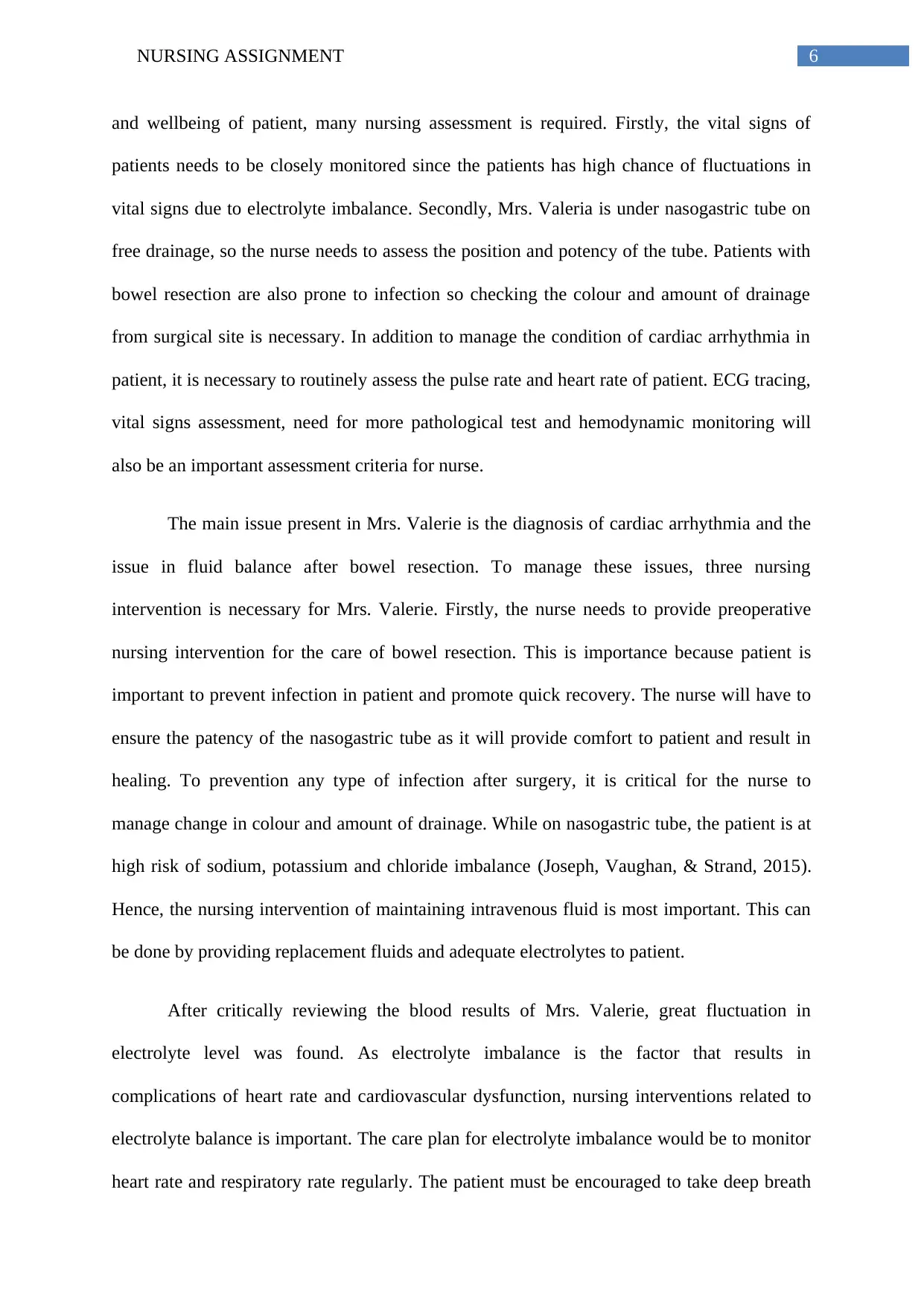
6NURSING ASSIGNMENT
and wellbeing of patient, many nursing assessment is required. Firstly, the vital signs of
patients needs to be closely monitored since the patients has high chance of fluctuations in
vital signs due to electrolyte imbalance. Secondly, Mrs. Valeria is under nasogastric tube on
free drainage, so the nurse needs to assess the position and potency of the tube. Patients with
bowel resection are also prone to infection so checking the colour and amount of drainage
from surgical site is necessary. In addition to manage the condition of cardiac arrhythmia in
patient, it is necessary to routinely assess the pulse rate and heart rate of patient. ECG tracing,
vital signs assessment, need for more pathological test and hemodynamic monitoring will
also be an important assessment criteria for nurse.
The main issue present in Mrs. Valerie is the diagnosis of cardiac arrhythmia and the
issue in fluid balance after bowel resection. To manage these issues, three nursing
intervention is necessary for Mrs. Valerie. Firstly, the nurse needs to provide preoperative
nursing intervention for the care of bowel resection. This is importance because patient is
important to prevent infection in patient and promote quick recovery. The nurse will have to
ensure the patency of the nasogastric tube as it will provide comfort to patient and result in
healing. To prevention any type of infection after surgery, it is critical for the nurse to
manage change in colour and amount of drainage. While on nasogastric tube, the patient is at
high risk of sodium, potassium and chloride imbalance (Joseph, Vaughan, & Strand, 2015).
Hence, the nursing intervention of maintaining intravenous fluid is most important. This can
be done by providing replacement fluids and adequate electrolytes to patient.
After critically reviewing the blood results of Mrs. Valerie, great fluctuation in
electrolyte level was found. As electrolyte imbalance is the factor that results in
complications of heart rate and cardiovascular dysfunction, nursing interventions related to
electrolyte balance is important. The care plan for electrolyte imbalance would be to monitor
heart rate and respiratory rate regularly. The patient must be encouraged to take deep breath
and wellbeing of patient, many nursing assessment is required. Firstly, the vital signs of
patients needs to be closely monitored since the patients has high chance of fluctuations in
vital signs due to electrolyte imbalance. Secondly, Mrs. Valeria is under nasogastric tube on
free drainage, so the nurse needs to assess the position and potency of the tube. Patients with
bowel resection are also prone to infection so checking the colour and amount of drainage
from surgical site is necessary. In addition to manage the condition of cardiac arrhythmia in
patient, it is necessary to routinely assess the pulse rate and heart rate of patient. ECG tracing,
vital signs assessment, need for more pathological test and hemodynamic monitoring will
also be an important assessment criteria for nurse.
The main issue present in Mrs. Valerie is the diagnosis of cardiac arrhythmia and the
issue in fluid balance after bowel resection. To manage these issues, three nursing
intervention is necessary for Mrs. Valerie. Firstly, the nurse needs to provide preoperative
nursing intervention for the care of bowel resection. This is importance because patient is
important to prevent infection in patient and promote quick recovery. The nurse will have to
ensure the patency of the nasogastric tube as it will provide comfort to patient and result in
healing. To prevention any type of infection after surgery, it is critical for the nurse to
manage change in colour and amount of drainage. While on nasogastric tube, the patient is at
high risk of sodium, potassium and chloride imbalance (Joseph, Vaughan, & Strand, 2015).
Hence, the nursing intervention of maintaining intravenous fluid is most important. This can
be done by providing replacement fluids and adequate electrolytes to patient.
After critically reviewing the blood results of Mrs. Valerie, great fluctuation in
electrolyte level was found. As electrolyte imbalance is the factor that results in
complications of heart rate and cardiovascular dysfunction, nursing interventions related to
electrolyte balance is important. The care plan for electrolyte imbalance would be to monitor
heart rate and respiratory rate regularly. The patient must be encouraged to take deep breath
Paraphrase This Document
Need a fresh take? Get an instant paraphrase of this document with our AI Paraphraser

7NURSING ASSIGNMENT
to avoid respiratory complications. Secondly, due to greater likelihood of symptoms of
dizziness, the nurse has a role in assessment of consciousness and neuromuscular function
(Williams & Hopper, 2015). Mrs. Valerie particularly has problem of decreased output and
taking steps regarding this is important. Based on the risk of different conditions like
hypernatremia or hypomagnesia, providing the required electrolyte will be important.
The third nursing intervention is related to the management of the condition of cardiac
arrhythmia. For this, it is necessary to control the erratic fluctuation of heart rate in patient. In
this situation, it will be necessary for the nurse to monitor pulse rate regularly. ECG tracing
and evaluation of ECG by regular consultation with physician is also critical to manage
adverse symptoms of patients. As the clinical issue of electrolyte imbalance is mainly caused
by the effect of certain drugs, it will be necessary to closely assess each medication before
giving to patient. Monitoring signs of drug toxicity is important to recognize irregular rhythm
and control them (Jurgens et al., 2015) .
Conclusion
The essay evaluated the condition of Mrs, Valerie, a patient with cardiac arrhythmia
and bowel resection through the discussion on the pathophysiology of the condition. The vital
signs of patient post operation and pathological results gave indication about the range of risk
and abnormalties in patient. The reasons for abnormality were adequately discussed with
support from evidence. Based on the examination of electrolyte imbalance issue and other
risk in patient, nursing interventions were adequately planned and summarized. This work
form the basis of evidenced based practice as all issues and care plan has been supported with
evidence based practice.
to avoid respiratory complications. Secondly, due to greater likelihood of symptoms of
dizziness, the nurse has a role in assessment of consciousness and neuromuscular function
(Williams & Hopper, 2015). Mrs. Valerie particularly has problem of decreased output and
taking steps regarding this is important. Based on the risk of different conditions like
hypernatremia or hypomagnesia, providing the required electrolyte will be important.
The third nursing intervention is related to the management of the condition of cardiac
arrhythmia. For this, it is necessary to control the erratic fluctuation of heart rate in patient. In
this situation, it will be necessary for the nurse to monitor pulse rate regularly. ECG tracing
and evaluation of ECG by regular consultation with physician is also critical to manage
adverse symptoms of patients. As the clinical issue of electrolyte imbalance is mainly caused
by the effect of certain drugs, it will be necessary to closely assess each medication before
giving to patient. Monitoring signs of drug toxicity is important to recognize irregular rhythm
and control them (Jurgens et al., 2015) .
Conclusion
The essay evaluated the condition of Mrs, Valerie, a patient with cardiac arrhythmia
and bowel resection through the discussion on the pathophysiology of the condition. The vital
signs of patient post operation and pathological results gave indication about the range of risk
and abnormalties in patient. The reasons for abnormality were adequately discussed with
support from evidence. Based on the examination of electrolyte imbalance issue and other
risk in patient, nursing interventions were adequately planned and summarized. This work
form the basis of evidenced based practice as all issues and care plan has been supported with
evidence based practice.

8NURSING ASSIGNMENT
Reference
Agus, Z. S. (2016). Mechanisms and causes of hypomagnesemia. Current opinion in
nephrology and hypertension, 25(4), 301-307.lar block. Heart Rhythm, 12(3), 498-
505.
Antzelevitch, C., Nesterenko, V., Shryock, J. C., Rajamani, S., Song, Y., & Belardinelli, L.
(2014). The role of late I Na in development of cardiac arrhythmias. In Voltage Gated
Sodium Channels (pp. 137-168). Springer Berlin Heidelberg.
Baruscotti, M., Bianco, E., Bucchi, A., & DiFrancesco, D. (2016). Current understanding of
the pathophysiological mechanisms responsible for inappropriate sinus tachycardia:
role of the If “funny” current. Journal of Interventional Cardiac
Electrophysiology, 46(1), 19-28.
DiCenso, A., Guyatt, G., & Ciliska, D. (2014). Evidence-Based Nursing-E-Book: A Guide to
Clinical Practice. Elsevier Health Sciences.
Efstratiadis, G., Sarigianni, M., & Gougourelas, I. (2006). Hypomagnesemia and
cardiovascular system. Hippokratia, 10(4), 147.
Hauptman, P. J., Burnett, J., Gheorghiade, M., Grinfeld, L., Konstam, M. A., Kostic, D., ... &
Zannad, F. (2013). Clinical course of patients with hyponatremia and decompensated
Reference
Agus, Z. S. (2016). Mechanisms and causes of hypomagnesemia. Current opinion in
nephrology and hypertension, 25(4), 301-307.lar block. Heart Rhythm, 12(3), 498-
505.
Antzelevitch, C., Nesterenko, V., Shryock, J. C., Rajamani, S., Song, Y., & Belardinelli, L.
(2014). The role of late I Na in development of cardiac arrhythmias. In Voltage Gated
Sodium Channels (pp. 137-168). Springer Berlin Heidelberg.
Baruscotti, M., Bianco, E., Bucchi, A., & DiFrancesco, D. (2016). Current understanding of
the pathophysiological mechanisms responsible for inappropriate sinus tachycardia:
role of the If “funny” current. Journal of Interventional Cardiac
Electrophysiology, 46(1), 19-28.
DiCenso, A., Guyatt, G., & Ciliska, D. (2014). Evidence-Based Nursing-E-Book: A Guide to
Clinical Practice. Elsevier Health Sciences.
Efstratiadis, G., Sarigianni, M., & Gougourelas, I. (2006). Hypomagnesemia and
cardiovascular system. Hippokratia, 10(4), 147.
Hauptman, P. J., Burnett, J., Gheorghiade, M., Grinfeld, L., Konstam, M. A., Kostic, D., ... &
Zannad, F. (2013). Clinical course of patients with hyponatremia and decompensated
⊘ This is a preview!⊘
Do you want full access?
Subscribe today to unlock all pages.

Trusted by 1+ million students worldwide
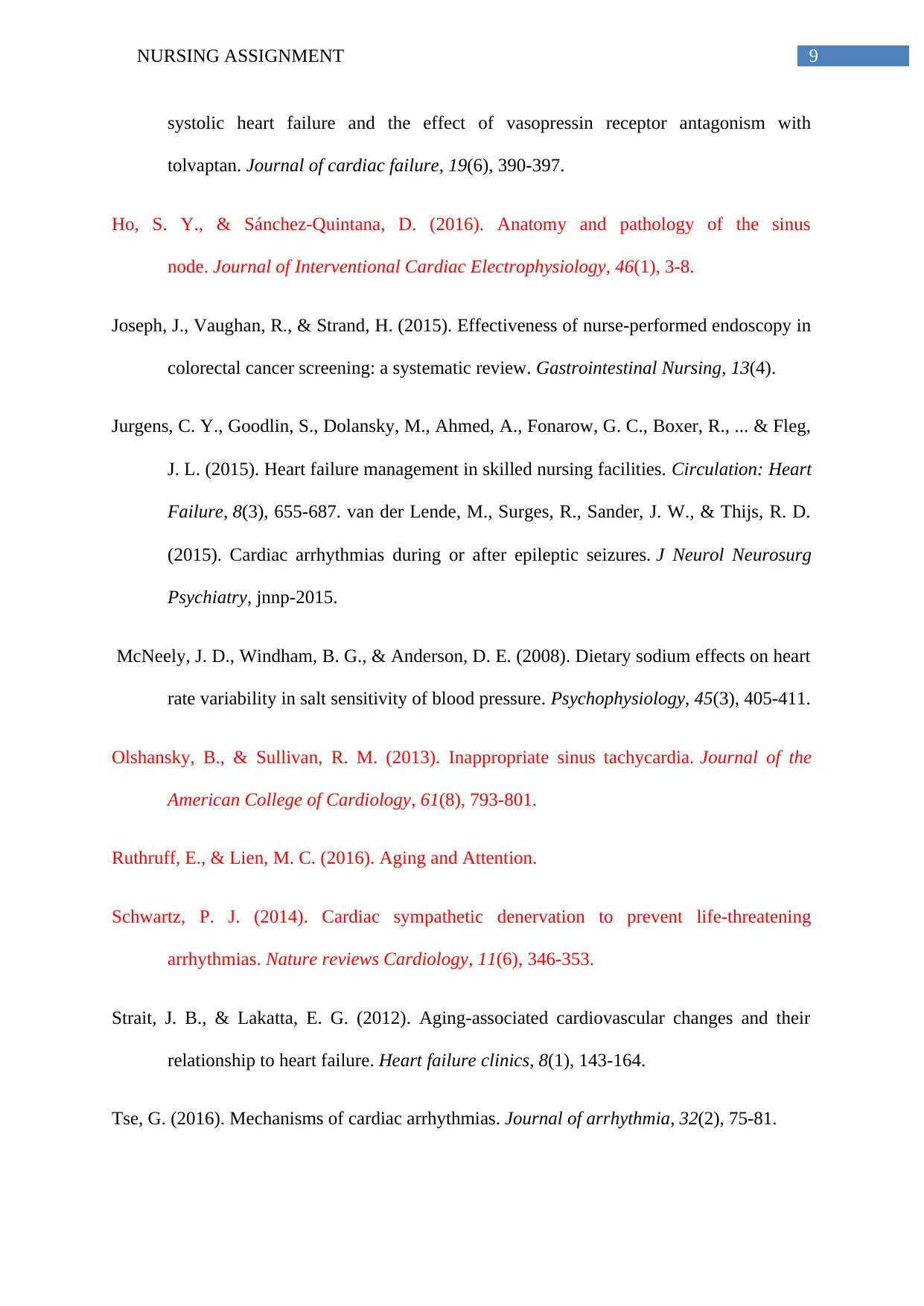
9NURSING ASSIGNMENT
systolic heart failure and the effect of vasopressin receptor antagonism with
tolvaptan. Journal of cardiac failure, 19(6), 390-397.
Ho, S. Y., & Sánchez-Quintana, D. (2016). Anatomy and pathology of the sinus
node. Journal of Interventional Cardiac Electrophysiology, 46(1), 3-8.
Joseph, J., Vaughan, R., & Strand, H. (2015). Effectiveness of nurse-performed endoscopy in
colorectal cancer screening: a systematic review. Gastrointestinal Nursing, 13(4).
Jurgens, C. Y., Goodlin, S., Dolansky, M., Ahmed, A., Fonarow, G. C., Boxer, R., ... & Fleg,
J. L. (2015). Heart failure management in skilled nursing facilities. Circulation: Heart
Failure, 8(3), 655-687. van der Lende, M., Surges, R., Sander, J. W., & Thijs, R. D.
(2015). Cardiac arrhythmias during or after epileptic seizures. J Neurol Neurosurg
Psychiatry, jnnp-2015.
McNeely, J. D., Windham, B. G., & Anderson, D. E. (2008). Dietary sodium effects on heart
rate variability in salt sensitivity of blood pressure. Psychophysiology, 45(3), 405-411.
Olshansky, B., & Sullivan, R. M. (2013). Inappropriate sinus tachycardia. Journal of the
American College of Cardiology, 61(8), 793-801.
Ruthruff, E., & Lien, M. C. (2016). Aging and Attention.
Schwartz, P. J. (2014). Cardiac sympathetic denervation to prevent life-threatening
arrhythmias. Nature reviews Cardiology, 11(6), 346-353.
Strait, J. B., & Lakatta, E. G. (2012). Aging-associated cardiovascular changes and their
relationship to heart failure. Heart failure clinics, 8(1), 143-164.
Tse, G. (2016). Mechanisms of cardiac arrhythmias. Journal of arrhythmia, 32(2), 75-81.
systolic heart failure and the effect of vasopressin receptor antagonism with
tolvaptan. Journal of cardiac failure, 19(6), 390-397.
Ho, S. Y., & Sánchez-Quintana, D. (2016). Anatomy and pathology of the sinus
node. Journal of Interventional Cardiac Electrophysiology, 46(1), 3-8.
Joseph, J., Vaughan, R., & Strand, H. (2015). Effectiveness of nurse-performed endoscopy in
colorectal cancer screening: a systematic review. Gastrointestinal Nursing, 13(4).
Jurgens, C. Y., Goodlin, S., Dolansky, M., Ahmed, A., Fonarow, G. C., Boxer, R., ... & Fleg,
J. L. (2015). Heart failure management in skilled nursing facilities. Circulation: Heart
Failure, 8(3), 655-687. van der Lende, M., Surges, R., Sander, J. W., & Thijs, R. D.
(2015). Cardiac arrhythmias during or after epileptic seizures. J Neurol Neurosurg
Psychiatry, jnnp-2015.
McNeely, J. D., Windham, B. G., & Anderson, D. E. (2008). Dietary sodium effects on heart
rate variability in salt sensitivity of blood pressure. Psychophysiology, 45(3), 405-411.
Olshansky, B., & Sullivan, R. M. (2013). Inappropriate sinus tachycardia. Journal of the
American College of Cardiology, 61(8), 793-801.
Ruthruff, E., & Lien, M. C. (2016). Aging and Attention.
Schwartz, P. J. (2014). Cardiac sympathetic denervation to prevent life-threatening
arrhythmias. Nature reviews Cardiology, 11(6), 346-353.
Strait, J. B., & Lakatta, E. G. (2012). Aging-associated cardiovascular changes and their
relationship to heart failure. Heart failure clinics, 8(1), 143-164.
Tse, G. (2016). Mechanisms of cardiac arrhythmias. Journal of arrhythmia, 32(2), 75-81.
Paraphrase This Document
Need a fresh take? Get an instant paraphrase of this document with our AI Paraphraser
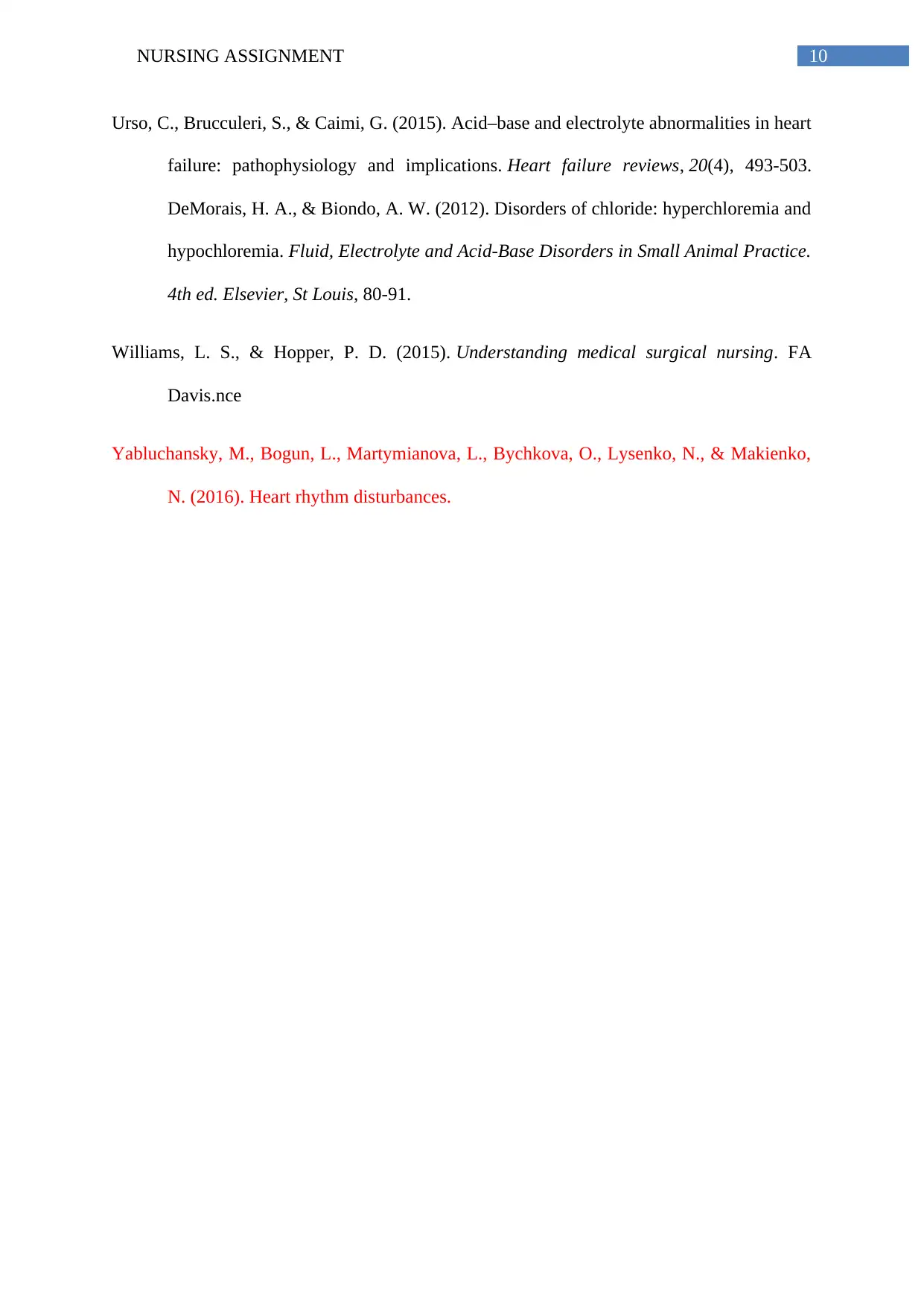
10NURSING ASSIGNMENT
Urso, C., Brucculeri, S., & Caimi, G. (2015). Acid–base and electrolyte abnormalities in heart
failure: pathophysiology and implications. Heart failure reviews, 20(4), 493-503.
DeMorais, H. A., & Biondo, A. W. (2012). Disorders of chloride: hyperchloremia and
hypochloremia. Fluid, Electrolyte and Acid-Base Disorders in Small Animal Practice.
4th ed. Elsevier, St Louis, 80-91.
Williams, L. S., & Hopper, P. D. (2015). Understanding medical surgical nursing. FA
Davis.nce
Yabluchansky, M., Bogun, L., Martymianova, L., Bychkova, O., Lysenko, N., & Makienko,
N. (2016). Heart rhythm disturbances.
Urso, C., Brucculeri, S., & Caimi, G. (2015). Acid–base and electrolyte abnormalities in heart
failure: pathophysiology and implications. Heart failure reviews, 20(4), 493-503.
DeMorais, H. A., & Biondo, A. W. (2012). Disorders of chloride: hyperchloremia and
hypochloremia. Fluid, Electrolyte and Acid-Base Disorders in Small Animal Practice.
4th ed. Elsevier, St Louis, 80-91.
Williams, L. S., & Hopper, P. D. (2015). Understanding medical surgical nursing. FA
Davis.nce
Yabluchansky, M., Bogun, L., Martymianova, L., Bychkova, O., Lysenko, N., & Makienko,
N. (2016). Heart rhythm disturbances.
1 out of 11
Related Documents
Your All-in-One AI-Powered Toolkit for Academic Success.
+13062052269
info@desklib.com
Available 24*7 on WhatsApp / Email
![[object Object]](/_next/static/media/star-bottom.7253800d.svg)
Unlock your academic potential
Copyright © 2020–2025 A2Z Services. All Rights Reserved. Developed and managed by ZUCOL.





